This issue opened with a poem titled “THERE’S WORK FOR ALL TO DO,” followed by an article titled “ALWAYS DO IT WELL,” espousing the value of diligence and care no matter how important the job. The final article on the page was titled “FORTY YEARS AGO,” that continued on page four and listed technological changes made over a forty year span of…
Arapaho

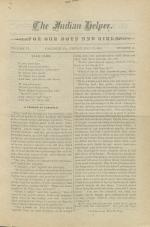
The first page opened with the poem "Take Care" followed by "A Visitor at Carlisle" which provided the opportunity to present arguments for Indian education away from the reservations. It continued on page four. Page two opened with an account of a presentation by "Dr. Harmon and Col. Thomas," a Dickinson College professor and his former…

This issue opened with a poem titled “A CLUSTER OF NEVERS,” from Selected, followed by a fictionalized conversation between two boys traveling to their homes in the west from Carlisle titled “TWO BOYS TALK IN THE CARS ON THEIR WAY HOME: WHAT THEY MAY HAVE SAID.” In the conversation, “Ira” and “Bart” muse about their appreciation of…

The first page opened with the poem "What a Jug Did," reprinted from An Old Scrap Book followed by a piece called "Nice Letter from Mr. Standing," made up of abstracts from his trip West returning Carlisle students to their home agencies. Standing mentioned there was a special travel car for girls and sick students, and described his…

This issue opened with a poem titled “EARNEST LIVING,” by C.M. Sheldon. The next article was written by Dessie Prescott (Sioux) titled “A FOURTH OF JULY CELEBRATION IN WHICH THE SISETON INDIANS PARTICIPATED,” which described the holiday program from 1884, in Sisseton, South Dakota, in which participants reenacted battles, held horse races and…
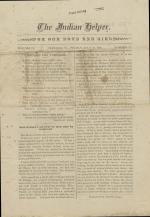
This issue opened with a poem titled “THROUGH AND THROUGH” reprinted from Scattered Seeds.” Also found on that page was “MISS WILSON’S ACCOUNT OF HER TRIP TO SCOTLAND,” a travelogue of the teacher and her sister’s visit by ocean liner to Scotland and Ireland and back. Page two opened with “A Child’s Wise Speech,” that described the…
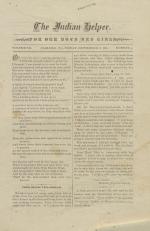
The first page opened with a temperance poem and a reprint of a letter received from Minnie Yellowbear, who returned to Indian Territory and was teaching at the Arapaho school. Page two reported the practice of government and missionary teachers using native language curricula along with English language curricula, and urged Carlisle students…
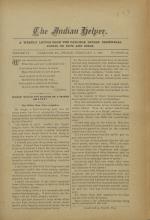
The first page began with an untitled poem that opened with the first line “We can never be too careful,” followed by “Which Would You Rather Be a Spider or a Fly? / The White Man Like a Spider,” an account of Mr. Seger’s description of the idiosyncrasies of language translation. It continued on the fourth page. Page two featured news articles…
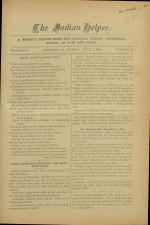
The first page opened with a poem by Susan Coolidge titled “New Every Morning,” followed by a letter from Ernie Black (Cheyenne) titled “News from our Cheyenne and Arapahoe Boys.” Also on the page was a reprint from The Sunday School Times titled “We Must Be Run Through a Mill.” Page two opened with a quote from Paul Boynton (Arapho)…
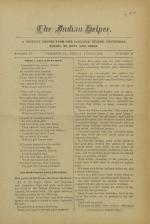
The first page opened with a poem by titled “When a Girl Knows How” to sew, bake and knit followed by “You Home-Going Boys and Girls: Will you be in the New or the Old of the Moon?” which asked J.H. Segar what the Cheyenne and Arapho boys and girls were doing at their agency in Cantonment, Oklahoma. Page two continued the news from Cantonment…
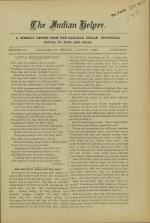
The first page opened with a poem “Little Moccasined Feet,” followed by the article titled “How Did There Come to be Any Coal?” that described the origin of coal. Page two opened with “Small Beginnings,” a litany of how Benjamin Franklin, Columbus, and others had their origins. “How One Conquers,” followed by “Luck and Labor,” as well as…
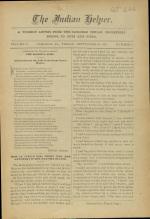
The first page opened with a poem "The Singer’s Alms: An Incident in the Life of the Great Tenor, Mario” by Henry Abbey, followed by the first installment in a series of articles written by the Man-on-the-Band-Stand about a Pueblo girl named Mollie. These stories were later published in book form in Stiya by Marianna Burgess, who…

The first page opened with a poem by E.G. titled "After Carlisle, What?” followed by the next installment of the series titled “How An Indian Girl Might Tell Her Own Story if She Had the Chance: Founded on Actual Observations of the Man-on-the-band-stand’s Chief Clerk” (continued from the previous week). The story continued on the fourth page.…
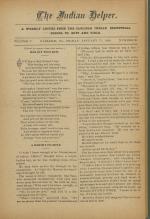
The first page opened with a poem titled "Hoe Out Your Row," followed by "A Worthy Example," that touted a fictional conversation between two boys musing on the accomplishments of Indian Commissioner T. J. Morgan. Page two included several articles and notices about country life for Outing students, news from the Omaha and Apache agencies, the…

A souvenir booklet from the Carlisle Indian School, published for their 23rd year. A short description of the aims and goals of the school is presented. Images of students as they first arrived, as well as important visiting chiefs, are given, as are before and after images including those of Tom Torlino. Extracurricular…
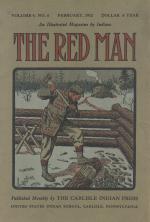
William B. Freer wrote about the second annual Southern Cheyenne and Arapaho Fair held in Watonga. He mentioned that between 2,000 and 2,500 Cheyenne and Arapaho attended the fair. Some of the events discussed were religious services; a lecture on tuberculosis and trachoma; and numerous exhibitions of livestock, produce, and farm practices. The…
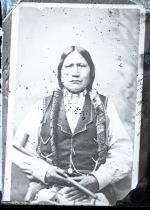
Photograph of a studio portrait of Black Coal, an Arapaho chief.
J.N. Choate took this photograph of the original photograph, but there is no information about the photographer of the original image.

Portrait of White Bear, Zonkeuh, Koba, Henry Roman Nose, Little Chief, Charles Oheltoint, Etadleuh Doanmoe, and White Man posed on the grounds of the school.
Note: The Cumberland County Historical Society notes the identification of these people is based on a copy of the image posted for sale on eBay. That copy was identitied as "…

Posed portrait of eight female students, presumably kitchen staff, and one staff member in the dining room with set tables.
Note: Three of these students are identified as Eva Pickard, Anna Laura, and Anna Raven.
![Eleven male Arapaho students [version 1], c.1880 Eleven male Arapaho students [version 1], c.1880](/sites/default/files/styles/views_taxonomy/public/image-photo/NAA_74284.jpg?itok=TeIRaP9l)
Studio portrait of eleven unidentified male students in school uniforms.
Previous cataloging identifies them as from the Arapaho nation, and the version of this image in Princeton's collection identifies them as being Northern Arapaho.
![Eleven male Arapaho students [version 2], c.1880 Eleven male Arapaho students [version 2], c.1880](/sites/default/files/styles/views_taxonomy/public/image-photo/Princeton_Northern%20Arapao%20Boys.jpg?itok=dNOgBseh)
Studio portrait of eleven unidentified male students in school uniforms.
The caption here identifies them as being Northern Arapaho.
![Left Hand and his son, U.S. Grant (Grant Left Hand) [version 1], c.1880 Left Hand and his son, U.S. Grant (Grant Left Hand) [version 1], c.1880](/sites/default/files/styles/views_taxonomy/public/image-photo/NAA_74311.jpg?itok=G5XkIOPr)
Studio portrait of Left Hand and his son, U.S. Grant (Grant Left Hand). Grant is wearing a school uniform.
![Left Hand and his son, U.S. Grant (Grant Left Hand) [version 2], c.1880 Left Hand and his son, U.S. Grant (Grant Left Hand) [version 2], c.1880](/sites/default/files/styles/views_taxonomy/public/image-photo/CCHS_PA-CH1_064a.jpg?itok=nJhWne8h)
Studio portrait of Left Hand, an Arapaho chief, with his son, U.S. Grant also known as Grant Left Hand.
The Cumberland County Historical Society has four copies of this image: PA-CH1-064a and CS-CH-044.1-.3.
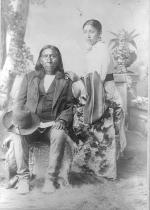
Studio portrait of visiting chief Little Raven with his daughter, student Anna Raven.
![Slate showing student work with names R. B. Hayes and John Williams [version 2], 1880 Slate showing student work with names R. B. Hayes and John Williams [version 2], 1880](/sites/default/files/styles/views_taxonomy/public/image-photo/CCHS_PA-CH1_023b.jpg?itok=ngW3nsT6)
Image of a slate such as those used by students. This slate contains examples of written vocabulary words, written text, a copy of a brief note from student R. B. Hayes to his father dated June 25, 1880, a drawing of a man on a horse apparently signed John Williams, and an example of a math problem. Along the side is written "Choate…
